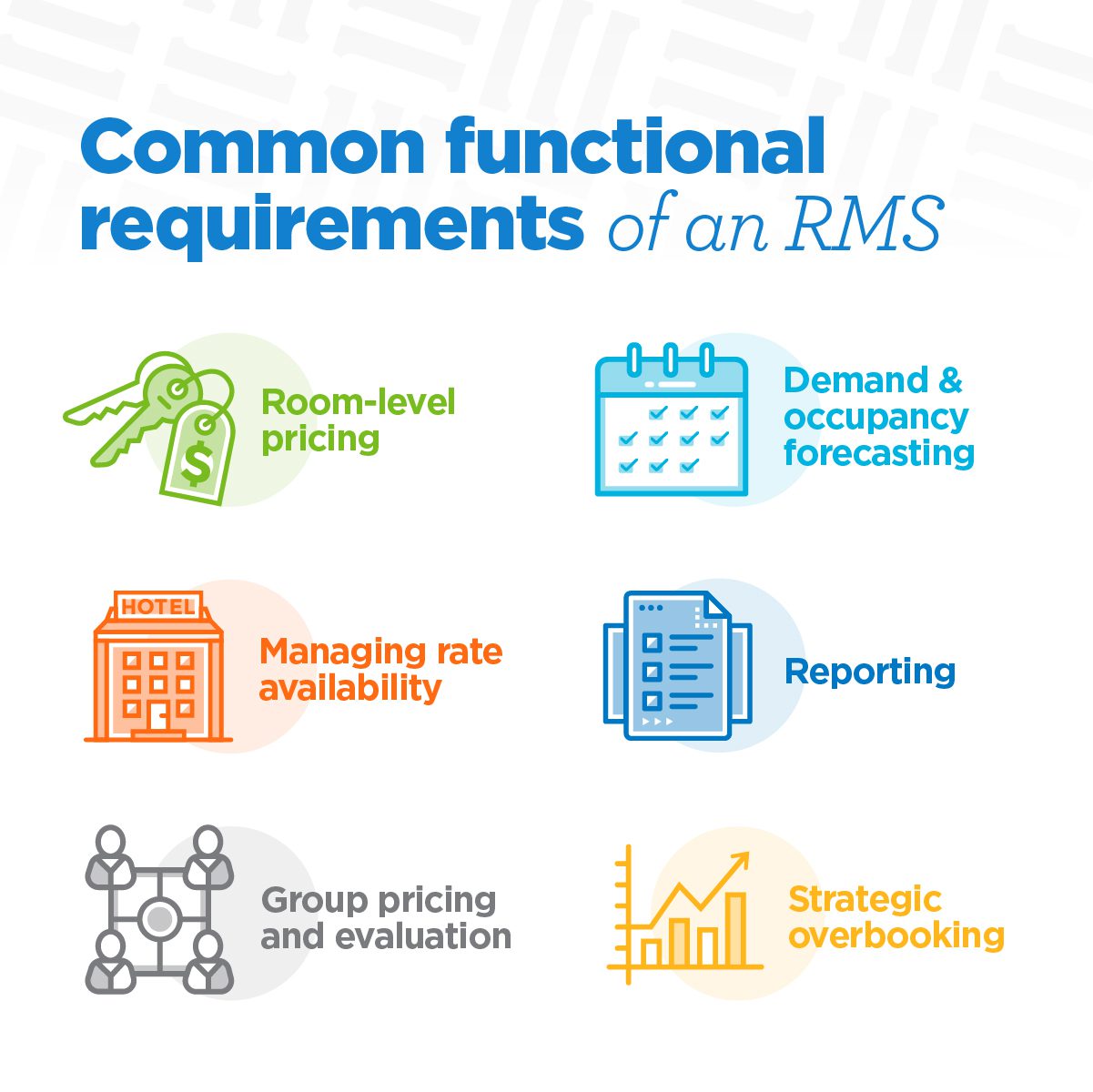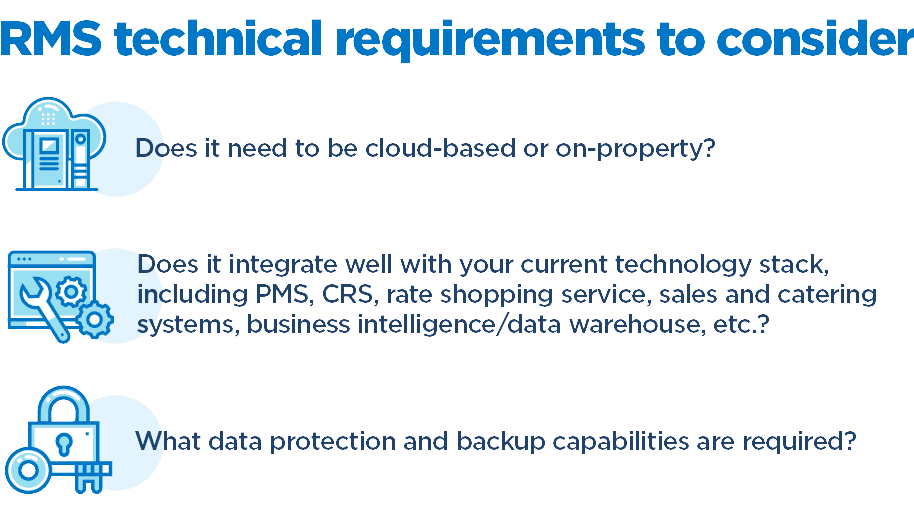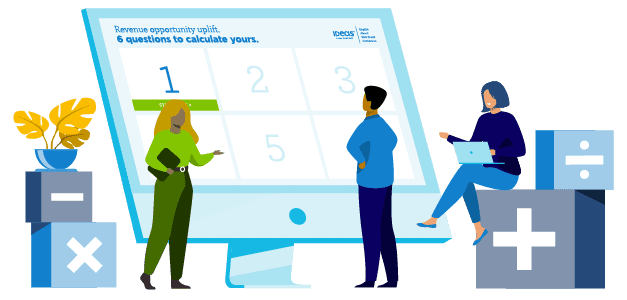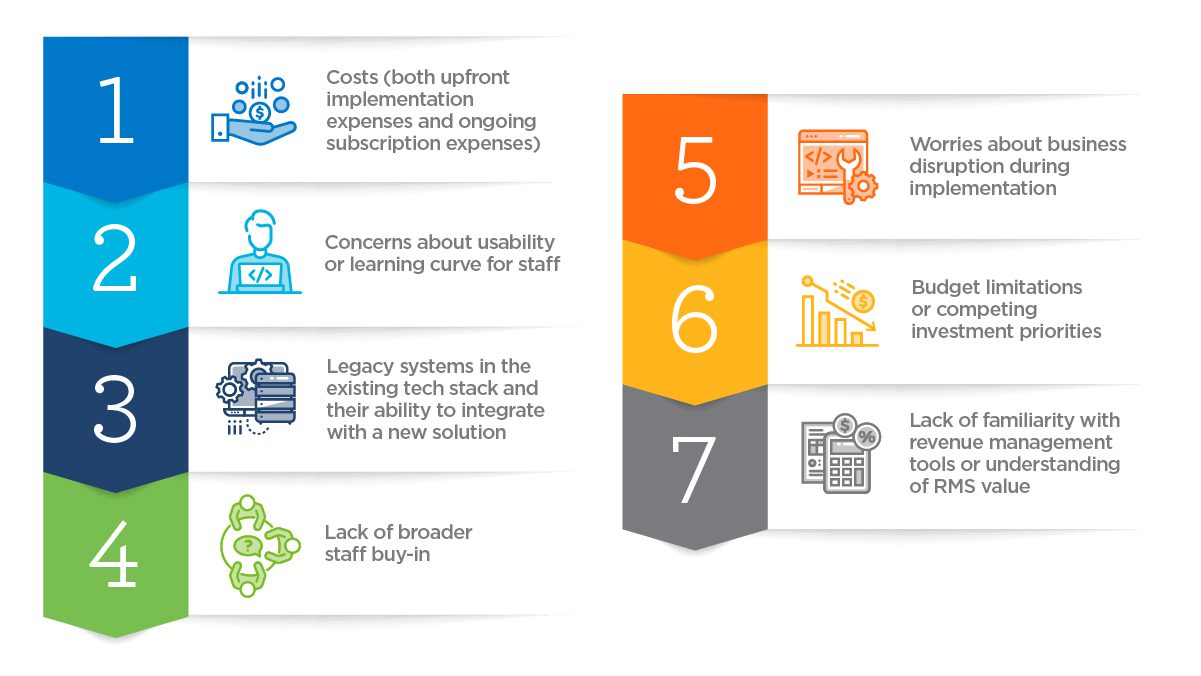Introduction
So you’ve decided a new revenue management system is the right tool for your organization to invest in.
While we’re certainly not surprised—after all, it’s hard to argue with results like improved RevPAR, increased occupancy and significant time savings through automation—getting the key decision-makers in your organization to reach the same conclusion isn’t always a simple task.
In all likelihood, there are multiple improvements and investments on your organization’s wish list. To get revenue management technology at the top of the list, you’ll want to build a business case that lays out a compelling argument for why the ROI of an RMS makes this investment a clear winner.
The prospect of preparing a business case can be intimidating, but we’re here to help make it as easy as possible. Read on for a comprehensive guide to building an RMS business case.
What is a business case and why do I need one?
A business case is simply a formal document or presentation that lays out the rationale for an investment or initiative.
When well-executed, a business case will:
- Outline objectives and benefits
- Demonstrate the ROI of the investment
- Identify risks and how they can be minimized
- Facilitate decision-making
- Secure funding and stakeholder buy-in
Ultimately, developing a business case is an exercise in showing to your organization’s key decision-makers that you’ve done your research and have thought the proposal through.
Leaders and stakeholders need a plan in place that accounts for everything from identifying the right solution to implementation and integration processes. Considering the wider changes or disruptions that can come from such an investment, it’s important to include input from senior leadership all the way down to the end business users.
With the right approach (and vendor partner), hoteliers can make the process as seamless as possible. By putting in the upfront work you’ll improve your chances of approval.
Common barriers to investing in an RMS
Crafting an effective and compelling business case for an RMS first requires understanding what’s likely to give stakeholders pause as they weigh your proposal. While you may not be able to account for or easily counter every concern, knowing what may be on the minds of your organization’s leadership will inform your approach.
Some of the most common barriers include:
- Costs (both upfront implementation expenses and ongoing subscription expenses)
- Concerns about usability or learning curve for staff
- Legacy systems in the existing tech stack and their ability to integrate with a new solution
- Lack of broader staff buy-in
- Worries about business disruption during implementation
- Budget limitations or competing investment priorities
- Lack of familiarity with revenue management tools or understanding of RMS value
The above are just starting points—you may encounter barriers unique to your property’s circumstances as you begin building your case and having initial conversations with stakeholders. The key point here is to have a solid understanding of the context surrounding your proposal so you’re prepared to address these barriers as well as you can.
“Having an automated RMS has really helped me strategize more. I can now quickly see the bigger picture and spend more time contributing to the things like marketing efforts and optimizing our online presence.”
Demonstrating the business impact of an RMS
Advanced automated revenue management systems like G3 RMS can have a transformational impact on your business. This tool supercharges your revenue and commercial team’s effectiveness by processing data and deploying revenue optimization decisions faster and more effectively than hoteliers who are relying on manual efforts alone could ever dream of.
Across the globe and at hotel properties of all shapes, sizes, and operating models, G3 RMS has consistently driven improvements to RevPAR, occupancy, lengths of stay, ADR, efficiency—and importantly—overall profitability. It’s easy to understand how that appeals to your organization’s decision makers, but you’ll need to provide some strong examples.
How to build a strong hotel revenue management system business case
With common barriers identified and a clear view of what your business case will hopefully accomplish, it’s time to roll up your sleeves and get started. Starting at square one likely feels daunting, but this guide and our interactive business case starter kit will help you break it down into achievable portions.
Find an executive sponsor
Pitching an RMS to your colleagues works best when you can recruit influential advocates for your cause. Ask yourself, ‘Who is a forward-thinking senior-level member in my organization who will most likely advocate for an RMS?’ This is the person you want on your side.
However, a receptive senior leader is only a start. This sponsor also needs a direct line of communication with the person in charge of making the final decision.
Once you have your sponsor, you’re off to the races. But don’t stop there. Consider finding another advocate or two if possible. At the very least, finding these additional advocates will allow you to refine your business case and identify weak points in your argument.
Identify the stakeholders who’ll benefit from an RMS
Of course, at a minimum everyone in your organization will indirectly benefit from the additional revenue and efficiency gains your revenue management system helps bring in. But not everyone will benefit directly.
If you can identify the key stakeholders that would benefit most from implementing an RMS, you’re well on your way to building a solid business case. The exact list will depend on the structure of your organization and the features you’re considering, but some common potential beneficiaries include:
- General managers
- Chief commercial officer
- Operations managers
- Strategy director
- Sales and marketing directors
- Finance directors
- Business analysts
The more individuals and departments you can identify as directly benefiting from a revenue management tool, the better. This is a numbers game, and it helps to show this investment has value to a broader group.
Demonstrate the need, not the want
Budgeting requires prioritization, and if the decision makers in your organization view an RMS as a luxury or a “nice-to-have” expense your proposal runs the risk of being deprioritized. When funding is tight, it’s important to highlight the value a new solution brings to the table.
Your job as a project sponsor is to get others to understand that a revenue management system truly is a need—not a want. After all, your competition very likely uses revenue management systems, and they’re raking in tons of extra revenue from doing so. That additional revenue is getting put to work running ads, creating marketing campaigns, and spreading the good news about their getaways to customers. And they’re not just any customers—they’re YOUR customers.
No need to let your competitors get the upper hand. You can use their decision to choose a revenue management system as your reason to adopt one. Use the fear of missing out (FOMO) to your advantage. We’re social creatures, and we tend not to like missing out on things, especially when it puts our professional well-being (and market share) at risk.
Here are some tactics for proving the need:

Use a survey to collect feedback from internal team members (sales, marketing, operations, etc.) affected by revenue management: Ask them about their confidence level in your current revenue management practices. Ask them about the impacts your current systems have on their departments. Allow them to rank their satisfaction with the current process and tools.

Find a credible industry report from a publication that speaks to the value of an automated revenue management system: Statistics from these reports speak loudly when it comes to justifying your case. Some excellent starting points include Skift Research, Phocuswright, CBRE, and Smith Travel Research (STR)

Get an idea of what the ROI—or better yet, ROU—might be for switching to a revenue management system.

Find a real-world example demonstrating how an RMS benefitted a property like yours.
Show how the RMS fits into your organization’s business strategy
Listing the benefits and statistics of adopting a revenue management system is a great start. But to make your business case air-tight, you must specify how an RMS would support your organization’s specific, overall business strategy and show that you’ve thought through implementation. This begins with outlining the purpose and objective of your automated revenue management system.
Start by defining what a revenue management system can feasibly accomplish and ask yourself:
- What business projects will this tool help us focus on?
- What types of revenue streams will it help price?
- How detailed would we like those pricing models to be?
For example, will you need an RMS to manage revenue streams from your organization’s meeting spaces and restaurants in addition to standard hotel rooms? Or does your organization need a system that only manages pricing and forecasting for individual guest rooms? Maybe you need a solution that helps with reporting and data warehousing or a solution that can also automate budgeting and forecasting. Asking these questions early on will help you define the scope of your project and narrow down your list of viable potential vendors.
Regardless of what purpose and objectives end up on the list of needs, you’ll need to connect each of these objectives back to the capabilities of the systems you have under consideration.
Identify the functional requirements of your revenue management system
As the project director, you need to specify as many relevant details as possible so that the finished product matches well with your organization’s requirements. Specifying a detailed vision of what your RMS needs to do helps your organization choose a product that meets defined business objectives.
So, what are some of the functional requirements you might look for in a revenue management system?

What are the technical requirements of an RMS? Some questions to consider:
Establish criteria for success
No decision-maker wants to sponsor a tool that fails to create measurable value. Decision makers have budgets to reconcile, owners to appease, and their reputations on the line. They might feel unwilling to stick their necks out for a solution that doesn’t have a clear ROI or a way to measure that ROI.
But why measure an ROI when you can measure an ROU?
Revenue opportunity uplift, or ROU, is an evolved form of ROI that offers a more accurate view of key performance indicators, such as occupancy, average daily rate (ADR), RevPAR, and total revenue. By combining these metrics into one indicator, ROU provides a comprehensive, actionable way to measure an RMS’s success and impact.
Try our Revenue Uplift Calculator Tool
Consider your alternative options to an RMS
This might seem counter-intuitive, but if you want to successfully pitch your organization on a revenue management system, you need to prepare for someone to ask, “What makes this solution better than the alternatives or what we already have?” Your colleagues will want an answer that puts them at ease.
Here’s what you do:
- List your alternatives to an RMS. That includes continuing the status quo, outsourcing revenue management to a consultant, or using a less powerful pricing system.
- Outline each option’s benefits, costs, feasibility, risks, and issues. For example, when revenue management is done on an ad-hoc basis, pricing rapidly falls out of date, causing revenue managers to waste time on non-revenue impacting tasks like data entry and reporting.
- Rank your alternative options from best to worst.
- Now list the costs and benefits of the RMS(s) you’re pitching. Again, show that you have a way to measure its success.
With alternatives thoroughly outlined and explored, you’ll demonstrate you’ve taken an objective approach to finding the best possible solution for your property’s needs.
Identify risks and adoption constraints
Besides the alternatives, you’ll want to also identify the factors that might lead to the underutilization of your system should it gain approval. The stakeholders you’re trying to convince will likely want to know what your plan is to address the following hurdles:

Lack of awareness: If you introduce an RMS and no one knows about it, what will you do to bolster awareness and build internal alignment? Are there internal channels of communication you can use to promote the solution? Are there particular managers or stakeholders you need to recruit as advocates and training partners?
Hesitation around adopting the tool: Lack of awareness is one thing. But if your colleagues know about the RMS and refuse to use it, that can lead to an even bigger challenge. Identify ways to remove friction to make the adoption process more accessible and less vague. Increasing transparency around the solution to show it will not replace anyone’s job, addressing pain points one-on-one, or bringing in the developer for support can help.

Lack of perceived value: If the stakeholders who would use an RMS don’t see its value, adoption could get tricky. Find or create resources you can use to show the value of your RMS. The right vendor partner will collaborate with you and your team on a rollout plan and tailored training materials.

Training constraints: Purchasing an RMS is one thing. Training people on how to use it is another. Identify what the training process will look like and outline ways to make the process as easy as possible. Lack of time, availability of trainers, and an organization’s size can bog down the onboarding process. As with the other obstacles, create a plan for how you’ll address these sticking points should someone ask about them during your internal pitch.
Plan a timeline
For your revenue management system proposal to get the stamp of approval, the decision-makers in your organization will need to have a timeline that maps the rollout process.
While RMS providers will do as much as possible to limit business disruptions during implementation, a timeline helps decision makers understand how long a property may be dealing with some temporary pain before seeing revenue gains.
At this stage in a proposal process, it’s best to keep it high level. There are quite a few variables that will impact implementation timelines, so be sure to ask potential RMS providers for input on what they think is most likely to be feasible. You can outline the details for the timeline once you get the metaphorical “green light” from the necessary stakeholders.
Additionally, you’ll want to consider the timing of your proposal. While some organizations may have the financial flexibility to invest whenever they see fit, many budgets are more-or-less locked in on a yearly cycle. It helps to propose significant investments like this while slightly ahead of your organization’s yearly budgeting season.
Looking for info on timelines, integrations, and other key details? We can help walk you through it.
Consider the financials—and then spell them out
This is arguably the most important piece of the puzzle—your leadership needs to see you’ve done your due diligence with regard to potential financial impact.
Typically, you’ll want to at least lay out:
- Costs: This includes up-front costs and on-going expenses directly related to the investment. Many cost analyses will use this information to provide a total cost of ownership (TCO) figure for a specific set of time (typically 3-5 years).
- Benefits: This includes direct benefits like projected revenue improvements and indirect benefits like projected cost savings.
- Payback period / break-even analysis: Based on total costs and projected benefits, when can they expect to have all up-front costs paid off? What level of revenue uplift is enough to break-even for ongoing expenses?
Revenue management systems have a very strong track record of delivering solid returns on investment—many owners see a five percent or more increase in their room revenue, with some hotels reporting improvements as high as 15 percent. That said, your credibility will be bolstered if this analysis includes a range of projections (ex: best-case, worst-case, and most-likely scenarios) to account for uncertainty.


Create an executive summary
As much as you’d like them to, decision-makers often lack time to read your business case word for word. The executive summary can help because it gives your decision-makers something they can make time for.
So, once your business case is all put together, distill all the major points into a few digestible paragraphs that articulate why an RMS is worth the investment. This might seem easy, but simplification can prove challenging. As the French philosopher and mathematician Blaise Pascal famously said, “I would have written a shorter letter, but I did not have the time.”
Present your business case (with confidence)
The final piece of the puzzle is developing an effective presentation for delivering your business case. At this stage you’ve completed the most challenging legwork—and that should be a big confidence booster.
So, when the moment you’ve been waiting for finally arrives, start your presentation with a quick elevator pitch that answers the “What? Why? and How?” immediately. Put your message in simple terms and consider telling a story or using an analogy to help your audience relate.
Think of this presentation as your chance to highlight your organization’s challenges and articulate how your proposed solution will help overcome those challenges. As we mentioned earlier, be prepared to address any risks or concerns you think your audience will have.
Remember, a polished presentation and confident delivery will help capture their attention!
Now’s the time to invest in revenue management technology
Revenue management technology’s influence on the industry isn’t likely to wane any time soon. In fact, Skift’s Hotel Tech Benchmark estimates more than 50% of hotel rooms globally are influenced by revenue management tools. Your property may not be an early-adopter at this stage, but this steady growth in RMS adoption is telling. These tools are a proven, valuable asset for hotels of all sizes and operating models, and delaying adoption means a growing number of your competitors will likely have a leg-up.
There’s no better time than now to start building your business case – and we’re happy to help! Check out our downloadable Business Case Starter Kit, and reach out to an IDeaS representative today to start gathering the key information you’ll need.
Check out our downloadable Business Case Starter Kit to help you get started.

